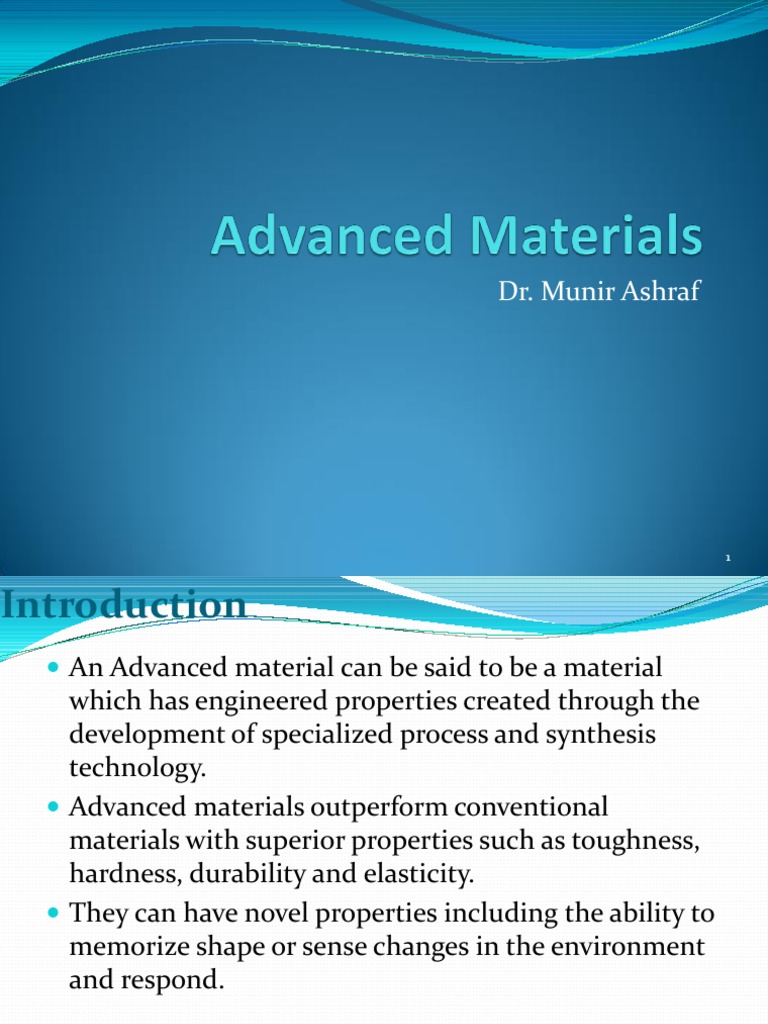Advanced materials can be likened to the intricate brushstrokes of a master painter, where each element contributes to a greater masterpiece. These materials are designed at the molecular and atomic levels, encapsulating a remarkable array of properties that elevate their function beyond traditional materials. Understanding the multifaceted characteristics of advanced materials is crucial for engineers and scientists alike, as they continue to redefine the boundaries of technology and innovation.
1. Exceptional Strength-to-Weight Ratios
One of the most universally acknowledged properties of advanced materials is their extraordinary strength-to-weight ratio. This characteristic enables applications in industries ranging from aerospace to automotive. For instance, carbon fiber composites exhibit exceptional tensile strength while remaining remarkably lightweight. This allows for the construction of aircraft that can withstand immense aerodynamic forces without the burden of excess weight, thus enhancing fuel efficiency.
2. Enhanced Durability
Durability can be viewed as the steadfast guardian of materials, ensuring long-lasting performance in diverse environments. Advanced materials such as titanium alloys exhibit resistance to corrosion and fatigue, making them ideal for use in marine applications and biomedical implants. The unique atomic arrangements in these materials create a formidable barrier against environmental degradation, allowing them to persist where ordinary materials might fail.
3. Controlled Thermal Properties
Advanced materials can be engineered to exhibit a broad range of thermal properties. This manipulation of thermal conductivity allows for applications in thermoelectric devices, where materials can either dissipate heat or harness it for energy conversion. For instance, the use of aerogels, known as “frozen smoke,” illustrates a remarkable ability to insulate against heat while maintaining a unique lightweight structure. Their ability to regulate temperature effectively opens doors to innovations in energy efficiency.
4. Tailored Electrical Conductivity
The domain of electrical conductivity invites one to explore the duality of insulators and conductors. Advanced materials, especially those incorporating nanostructures, grant scientists the ability to engineer materials with specific electrical properties. Graphene, for example, stands out for its exceptional electrical conductivity, outperforming traditional conductors while offering flexibility and mechanical resilience. This capability paves the way for advancements in next-generation electronics and energy storage solutions.
5. Magnetic Properties
The allure of magnetism, reminiscent of the invisible forces that govern celestial bodies, finds its parallel in the realm of advanced materials. Materials such as high-temperature superconductors exhibit unique magnetic properties that facilitate magnetic levitation and lossless energy transfer. By manipulating electron spin and alignment within these materials, researchers are unlocking possibilities for revolutionary applications in maglev transportation systems and powerful MRI machines.
6. Reactivity and Chemical Stability
Advanced materials often exhibit engineered reactivity that enables them to participate in chemical reactions without undergoing degradation themselves. This property is particularly vital in catalysis, where advanced materials can accelerate reactions and increase efficiency. Metal-organic frameworks (MOFs), for instance, are renowned for their vast surface areas and tunable porosity, making them excellent candidates for gas storage and separation tasks while maintaining chemical stability in various environments.
7. Biocompatibility
In the arena of biotechnology, the biocompatibility of advanced materials serves as a critical parameter. Materials that are non-toxic and support cellular growth and integration are paramount in medical applications. Polymers injected for drug delivery or scaffolds designed for tissue engineering must harmonize with biological systems. The unique characteristics of advanced biopolymers enable the innovative interplay of materials with biological tissues, inspiring breakthroughs in regenerative medicine.
8. Dynamic Responsiveness
Imagine a material that reacts to its surroundings as fluidly as the tides shift with lunar gravity. This concept is embodied in smart materials, which can adapt their properties in response to external stimuli like temperature, light, or stress. Shape memory alloys, for instance, can return to a predetermined shape after deformation, offering intriguing applications from medical devices to aerospace engineering. The dynamic nature of these materials signifies a shift toward adaptable technologies that respond proactively to their environments.
9. Sustainability and Eco-friendliness
As humanity inches toward an era of sustainable engineering, the role of advanced materials in promoting eco-friendliness cannot be overstated. The development of biodegradable polymers and recyclable composites showcases the potential for advanced materials to minimize ecological footprints while maintaining high performance. This symbiotic relationship between innovation and environmental stewardship is pivotal in creating a sustainable future.
10. Multiscale Integration
Finally, the property of multiscale integration presents a compelling vantage point from which to observe the interaction of advanced materials across different scales, from the nanoscopic to the macroscopic. This ability facilitates the creation of systems that function seamlessly, such as composite materials that integrate nanoscale reinforcements within bulk matrices. The synergy of these interactions often results in properties that are superior to their individual counterparts, highlighting the potential for groundbreaking advancements in engineering design.
In conclusion, the properties of advanced materials are akin to a symphony, wherein each characteristic harmonizes with the others to produce innovative solutions across a myriad of applications. As technology progresses, our understanding of these materials will only deepen, heralding an era of unprecedented advancements in various domains. These properties collectively position advanced materials as pivotal players in shaping the future landscape of science and engineering.












